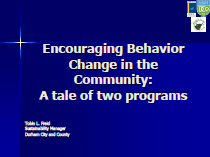Neighborhood-Based Home Energy Efficiency Upgrades
Learn about other climate showcase communities.
City of Durham and Durham County, North Carolina
Project Timeline: February 2010 – December 2013
- Latest Update
- Photos and Video
- Project Summary
- Community Characteristics
- Program Results
- Project Website
Latest Update
EPA-funded home retrofit projects under the Clean Energy Durham project been completed, while other elements of the project have been extended through the end of 2013. The Neighborhood Energy Retrofit Program (NERP) team used technology to increase retrofit service productivity by streamlining the online application process and entering assessment data into a database while onsite. The Home Energy Savings Program (HESP) reached out to applicants who had incomplete applications, and a total of 323 home retrofits were completed as of mid-2013. The project also continued to solicit feedback from participants. A survey of NERP and HESP participants found that saving energy and money were the most important motivating factors for participating, along with reducing greenhouse gas (GHG) emissions and improving the comfort and value of their homes. A follow-up survey was completed by 310 participants, and the data were analyzed by graduate students from Duke University. The City also requested electricity data from program participants and those data will be analyzed, as well. Clean Energy Durham held eight basic energy efficiency (BEE) workshops and two hands-on-workshops (HOW) in Spanish, reaching a total of 39 attendees. Finally, the City of Durham has continued implementing its social marketing campaign called “Charge Ahead Durham” to encourage residents to reduce energy and water use, improve water quality, and reduce waste and pollution. A web application developer has begun work on the site, which is expected to be launched in the fall of 2013. Upcoming work includes surveying participants who have not yet completed the HESP survey, gathering feedback from BEE and HOW workshop participants, and developing program materials for Charge Ahead Durham.
Photos and Video
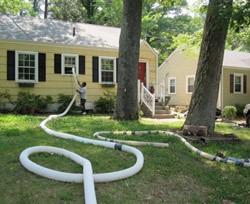 By June 2011, Durham completed a total of 44 assessments and 21 retrofits, for a total of 25,994 square feet of retrofitted space.
By June 2011, Durham completed a total of 44 assessments and 21 retrofits, for a total of 25,994 square feet of retrofitted space.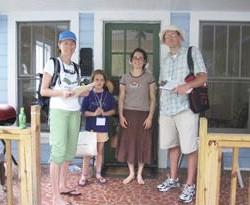 Volunteers go door-to-door in the Morehead Hill-West End Neighborhood to share information about Durham's Neighborhood Energy Retrofit Program.
Volunteers go door-to-door in the Morehead Hill-West End Neighborhood to share information about Durham's Neighborhood Energy Retrofit Program.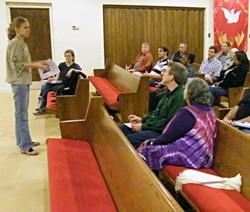 Volunteers for the Parkwood Neighborhood of Durham meet to receive training and support.
Volunteers for the Parkwood Neighborhood of Durham meet to receive training and support.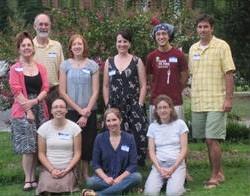 Volunteers for the Trinity Park Neighborhood at their Neighborhood Energy Retrofit Program training.
Volunteers for the Trinity Park Neighborhood at their Neighborhood Energy Retrofit Program training.Project Summary
Promoting Energy Efficient Retrofits, Neighbor-to-Neighbor Training, Energy Efficiency Literacy and Skills Training, and Landlord-Tenant Program Support
The City of Durham and Durham County, North Carolina, are working together on a neighborhood-based, residential energy upgrade and capacity-building program. The project is reducing energy use and associated GHG emissions from at least 344 homes. A key component of the program strategy is the use of neighborhood organizing, which allows the implementation of several highly-effective and commonly needed efficiency upgrades to a large number of homes. This effort is paired with energy efficiency education for individuals and small groups.
Community volunteers bring residents in selected neighborhoods into the program via door-to-door outreach. The program targets households with earnings at more than 200 percent of the poverty level who are asked to contribute a cost-share to the upgrades. Households below this income threshold are referred to the City's Weatherization Assistance Program, which can provide greater assistance with no cost-sharing requirement. Eligible homes include those that are either owner-occupied or renter-occupied, no larger than 2,000 square feet, and single story. Implementation of this basic set of criteria allows maximum efficiency for the program and provides opportunities for newly-trained retrofit workers.
For renter-occupied properties, a program manager contacts property owners to negotiate permission for upgrades and provide information to the owners on the marketability of energy efficiency. Because education is an important component of this program, all residents and property owners that are contacted are given information on all available energy efficiency assistance (through local, state, and federal sources), regardless of whether they choose to participate in the program.
The City of Durham is contracting with a community organization to manage community outreach, including volunteer recruitment and education, program material development, volunteer training, and data collection and analysis. The City is also contracting with local companies to conduct basic energy audits and to install the targeted energy efficiency upgrades. Upgrades that are included in the program are limited to those that are needed in nearly all residences, can be completed without an exhaustive energy audit, and can result in significant energy savings with minimal up-front cost.
Community Characteristics
Population 201,000
Area 95 square miles
Government Type County
Community Type Urban
Median Household Income 47,070
Program Results
|
Reported Results (as of June 2013) |
Projected Cumulative Results |
|
|---|---|---|
|
Annual GHG Reductions |
677 mt CO2e |
1,800 mt CO2e |
|
# of Households Retrofitted |
323 |
344 |
|
Hours of Paid Work Created |
6,667 |
4,471 |

